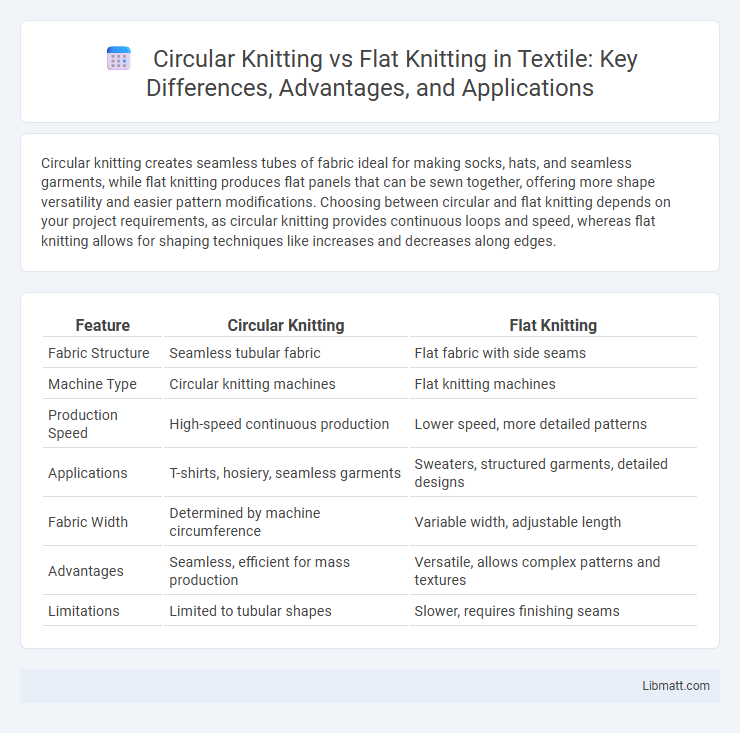Circular knitting creates seamless tubes of fabric ideal for making socks, hats, and seamless garments, while flat knitting produces flat panels that can be sewn together, offering more shape versatility and easier pattern modifications. Choosing between circular and flat knitting depends on your project requirements, as circular knitting provides continuous loops and speed, whereas flat knitting allows for shaping techniques like increases and decreases along edges.
Table of Comparison
| Feature | Circular Knitting | Flat Knitting |
|---|---|---|
| Fabric Structure | Seamless tubular fabric | Flat fabric with side seams |
| Machine Type | Circular knitting machines | Flat knitting machines |
| Production Speed | High-speed continuous production | Lower speed, more detailed patterns |
| Applications | T-shirts, hosiery, seamless garments | Sweaters, structured garments, detailed designs |
| Fabric Width | Determined by machine circumference | Variable width, adjustable length |
| Advantages | Seamless, efficient for mass production | Versatile, allows complex patterns and textures |
| Limitations | Limited to tubular shapes | Slower, requires finishing seams |
Introduction to Circular and Flat Knitting
Circular knitting uses a continuous loop to create seamless tubes, ideal for producing socks, hats, and seamless garments with fewer finishing steps. Flat knitting involves back-and-forth rows, producing flat pieces that require sewing to form the final shape, suitable for structured or shaped items like sweaters and cardigans. Your choice depends on the desired fabric structure, garment design, and production efficiency.
Key Differences Between Circular and Flat Knitting
Circular knitting produces seamless tubes, making it ideal for continuous fabric like socks or sleeves, whereas flat knitting creates flat panels that require stitching to form garments. Circular machines knit in a continuous spiral, offering faster production and fewer seams, while flat machines knit back-and-forth rows, allowing more complex patterns and shapes. Your choice depends on the desired final product's shape, speed, and design intricacy, with circular knitting favoring seamless items and flat knitting supporting detailed customization.
Tools and Equipment Used in Both Methods
Circular knitting employs a continuous round needle or a set of double-pointed needles to create seamless tubes, ideal for making socks, hats, and sleeves. Flat knitting utilizes straight needles or a pair of single-pointed needles to produce flat pieces that are later sewn together, commonly used for sweaters and scarves. Both methods require yarn, tension tools, and stitch markers, but circular knitting demands more specialized needles to maintain the looped construction.
Techniques and Stitch Patterns
Circular knitting uses continuous rounds on a circular needle, creating seamless tubes ideal for garments like hats and socks; it allows for uniform stitch tension and consistent patterns such as stockinette and ribbing. Flat knitting involves working back and forth in rows on straight needles, producing a flat piece that requires seaming to form garments, and supports diverse stitch patterns including cables and lace. Both techniques offer distinct textural effects, but circular knitting excels in crafting smooth, uninterrupted surfaces, while flat knitting provides versatility in stitch manipulation and shaping.
Seamless vs Seamed Garments
Circular knitting produces seamless garments by continuously knitting in a round, eliminating the need for stitching and resulting in smoother, more comfortable wear. Flat knitting creates seamed garments by knitting back and forth in rows, requiring additional stitching to join pieces together, which can affect the fit and flexibility. For your projects, seamless circular knitwear offers enhanced comfort and durability, while flat-knit garments provide design versatility through precise shaping and panel construction.
Speed and Efficiency Comparison
Circular knitting offers higher speed and efficiency due to its continuous, tubular production process, reducing the need for frequent needle repositioning. Flat knitting requires more time as it involves back-and-forth motions, making it less efficient for large-scale or seamless garment manufacturing. Your choice depends on whether you prioritize rapid output or intricate stitching versatility.
Versatility and Project Suitability
Circular knitting offers greater versatility for creating seamless, tubular projects such as hats, socks, and sweaters, making it ideal for garments that require continuous rounds. Flat knitting is better suited for projects requiring shaping and complex patterns, including scarves, blankets, and pieces that need to be sewn together later. Both methods accommodate diverse designs, but circular knitting excels in efficiency and seamless construction, while flat knitting provides flexibility for intricate stitch work and shaping.
Advantages of Circular Knitting
Circular knitting offers significant advantages such as producing seamless tubular fabrics, which enhances garment comfort and eliminates the need for side seams that can cause irritation. This method increases production efficiency by allowing continuous knitting without turning the work, reducing time and labor costs. Your projects benefit from consistent stitch tension and smoother finishes, making circular knitting ideal for creating socks, hats, and seamless sweaters.
Benefits of Flat Knitting
Flat knitting offers precise control over stitch patterns and shaping, making it ideal for creating detailed, customized garments. This method reduces fabric distortion and provides consistent tension, resulting in higher-quality finished products. Your ability to easily add seams or combine pieces enhances design flexibility and ease of garment assembly.
Choosing the Right Method for Your Project
Circular knitting produces seamless tubes, ideal for creating garments like hats, socks, and sleeves with continuous rounds, saving time and reducing finishing work. Flat knitting works back and forth in rows, allowing for more complex stitch patterns and shaping, preferable for pieces requiring flat panels or detailed designs. You should choose circular knitting for efficient, seamless projects and flat knitting when precision and intricate patterns are paramount.
Circular knitting vs Flat knitting Infographic

 libmatt.com
libmatt.com